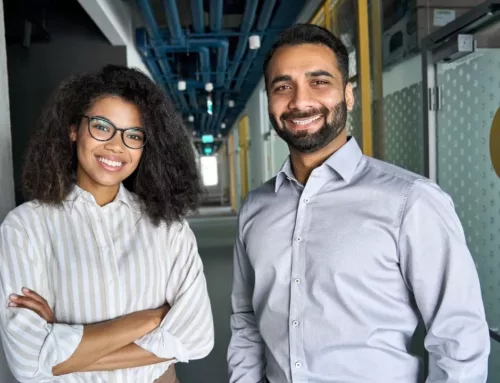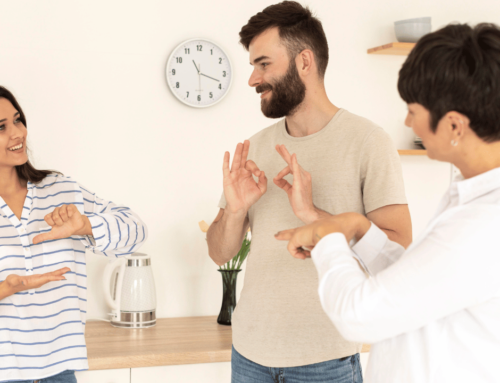Norman Rockwell’s iconic Thanksgiving dinner painting is a picture of joy and connection. But for most deaf people, dinner hurts. There’s even a name for it: Dinner Table Syndrome, a phenomenon in which deaf people are cut out of conversations while surrounded by hearing people they can’t understand during meals.
In pop culture, a key example of Dinner Table Syndrome is “Tribes” by playwright Nina Raine. Opening the play with a chaotic dinner scene. Squabbling family members talking over each other. At 100 words per minute (or so it feels) ,the lead character, Billy, eats in silence.
He is the only deaf person in his British family. Billy’s father is studying hard to become fluent in Mandarin.
However, he never bothers to learn sign language for his child, let alone make sure Billy’s included in conversations. Only after dinner is nearly over does Billy finally utter his first line: “What are you all talking about?”

ID: a white male is eating alone
Billy’s isolation hits deaf and hard of hearing audiences in the gut. We know it all too well. Drama Desk Award-winning play showcases how hearing audiences see a deaf person quickly (even one with some speech and speechreading ability) gets drowned in a tsunami of words he’ll never catch.
On some level, deaf and hard of hearing individuals do expect microaggressions routinely: missing the watercooler gossip at work, or being snubbed as consumers at stores and other places of business. But while dining with loved ones, the pain hits harder.
Kitchens are such communal spaces, after all, that each scene of TRIBES begins and ends in a kitchen.
Dinner Table Syndrome’s Impact on Relationships
Dinner Table Syndrome is becoming a form of oppression (almost always unintended). And while not an official medical diagnosis, it impacts our families, how we form romantic relationships and friendships, and even our professional lives in fields that involve networking over coffee or dinner.
Dinner table syndrome doesn’t just happen at the dinner table around conversations about current events or graduation ceremonies coming up. (cont.)
— phelan • ᜉᜌᜎᜈ᜔ 🏳️🌈 (@signingmango) October 10, 2021
“What did you say”? “What’s so funny”? “Nothing”? “Ohhh”? Ever felt invisible? REMINDER TO join us tonight for our premiere on The Dinner Table Syndrome tonight! 7 pm ET Facebook/thesoundoffladies or at our YouTube channel! See you then! pic.twitter.com/zXgNqAkD6G
— The Sound Off Ladies (@SoundOffLadies) November 12, 2020
I have a deaf joke about the dinner table syndrome, but oh never mind, I’ll tell you later.
— Joseph Hill, PhD. (@jaceyhill) July 25, 2020
How to Overcome Dinner Table Syndrome
As children, the teeth of deaf and hard-of-hearing people are usually grit by them, meals wolfed down, and they ask to excuse themselves early. Some cope by reading books at the table; others sketch pictures of silverware. Almost all zone out. As we grow into adults with disposable income and the freedom to choose. We then become selective about restaurants. Everything is as important as the food, from good lighting to patient servers.
Some tools, like speech-to-text apps and online ordering platforms, make dining out and home deliveries a little easier. But technology is only part of the solution. Deaf and hard-of-hearing customers wish for a human connection. Small talk with their servers, baristas, bartenders, and the ability to pass their compliments to the chef.
To bring the deaf-friendly and social element back into dining, deaffriendly Consulting recently launched a course to help dining businesses serve Deaf and hard of hearing customers better: Deaf Friendly Dining. In under 60 minutes, the course spans five modules taught by deaffriendly Trainer Vicki Moseley. Moseley is Deaf and ASL-fluent, with deep food-oriented roots: her family owned multiple BBQ and catering businesses. Building that empire alongside her family, she became an expert at self-advocacy and communication through countless deaf/hearing restaurant interactions.
On deaffriendly, the U.S.’s central consumer review platform with reviews by deaf and hard of hearing Americans in all 50 states. Our most popular review categories are restaurants/dining. It’s a matter of volume. At the same time, our annual doctor visits are critical. The reality is that we go to restaurants far more often.
The restaurant/dining industry is undergoing a massive shift during the pandemic: masked servers, the surge in takeout versus in-person dining, always-shifting COVID protocols, streateries, and relentless staffing shortage. But for 48 million hungry deaf and hard of hearing patrons, dining out (or via takeout) is still an experience and not merely a convenience. We’re in it for friendly service as much as for food itself.
Do you work in the dining industry?
Sign up for our Deaf-Friendly Dining course today, and put those skills to work immediately. BONUS: You’ll get access to a valuable ASL video demo (taught by ASL instructor Rachel Berman-Kobylarz, who also doubles as a ASL teacher at Northeastern University) on the most commonly used signs in the dining industry.






